Hi all,
There are some link about hungarian military.
www.roncskutatas.hu
http://hadsereg.uw.hu
www.worldwar2.gportal.hu
www.bibl.u-szeged.hu/bibl/mil/ww2/index.html

Hi all,
There are some link about hungarian military.
www.roncskutatas.hu
http://hadsereg.uw.hu
www.worldwar2.gportal.hu
www.bibl.u-szeged.hu/bibl/mil/ww2/index.html
Indeed useful and truly appealing links Sir, however they all are suffering from one and only tiny deficiency – exploitable color photos about the WW II era are not included in their offer.
Accordingly to that, I took the liberty to reveal some till now unpresented color pictures about Hungarian army. These pictures were taken back there in September of 1940, upon reinstatement of northwestern Romanian province of Transilvania (Erdély) to Hungary.
As you already know, honorable ladies and gentlemen, after the agreement between Hitler’s Germany and Stalin’s USSR, Romania has lost her provinces Besarabia and Northern Bucovina to USSR. On June 27, the Soviet Union occupied Bessarabia and northern Bukovina, and in accordance with the Second Wienna’s Decree of August 30, 1940 (directly mediated by Germany and Italy) Romania was forced to abandon Northern Transylvania as well, and to pass on aforementioned province back to Hungary. The Romanian civilian and military authorities had only four days to withdraw (between 1 - 4 September), and all those occurrences happened without a single shot fired.
However, Hungarian Ministry of Propaganda was already tremendously prepared for the aforesaid occasion, and at least 15 well equipped and professionally trained photographers were enlisted, with single task commanded: comprehensive photographic coverage regarding triumphal ingression of Hungarian troops. They have staggeringly fulfilled their duty.
And so, here they are:
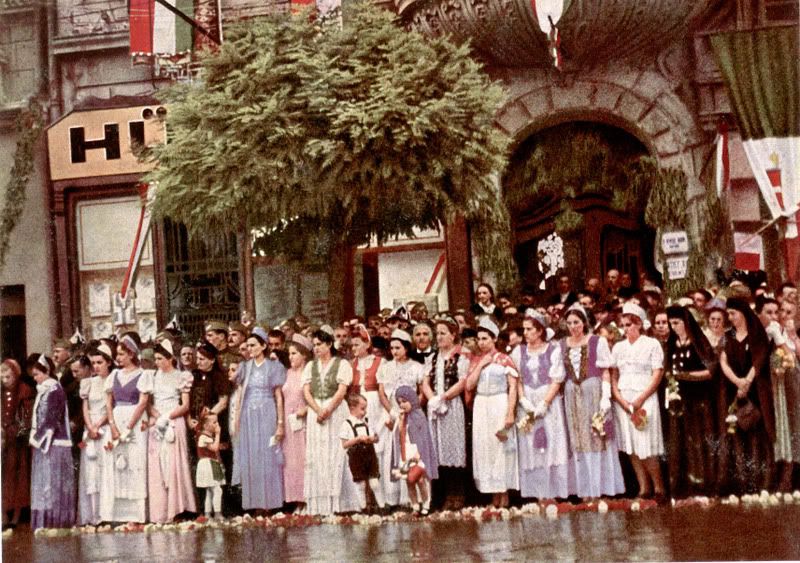
Inscription: Kluj – Kolozsvár, September 11, 1940 - They are waiting our home-defenders - Várják honvédeinket (photo taken by Sándor Ginzery)
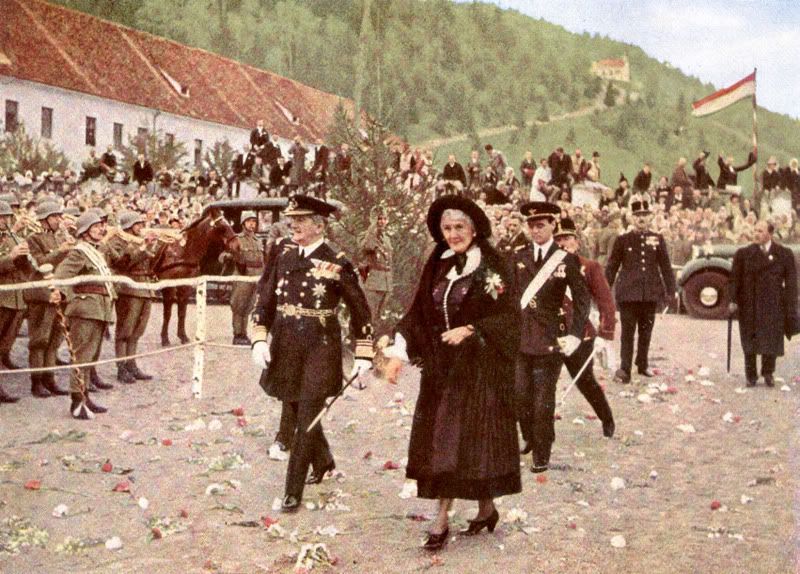
Inscription: Kluj – Kolozsvár, September 11, 1940 – Highly Dignified pair on a returned soil – A Főméltóságú pár a hazatért földön (photo taken by Balogh Rudolf)
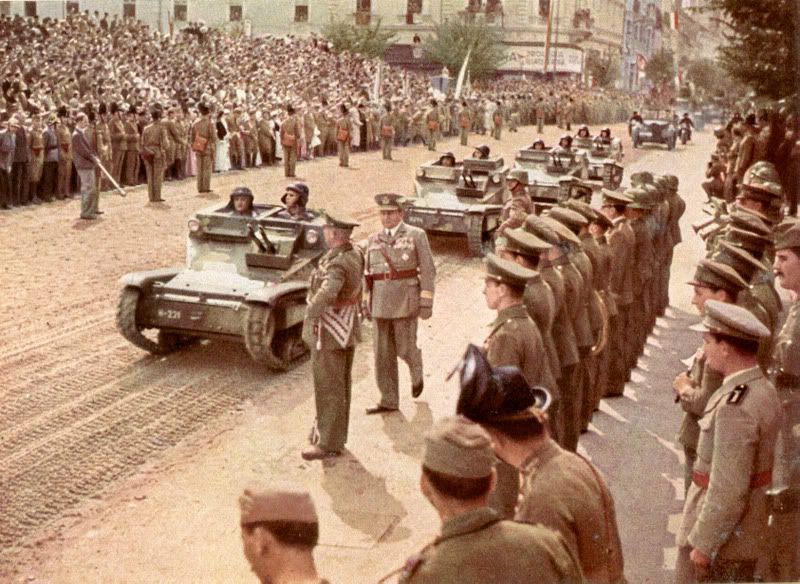
Inscription: Kluj – Kolozsvár, September 11, 1940 – Armored Company on parade – Harckocsi század díszmenete – (photo taken by Balogh Rudolf)

Inscription: Kluj – Kolozsvár, September 11, 1940 – Heavy artillery on parade – Nehéz tüzérség díszmente – (photo taken by Balogh Rudolf)
And that’s not all, honorable ladies and gentlemen. To be continued…
As previously promised, honorable ladies and gentlemen, here is the second part of the special Hungarian armed forces photo-coverage regarding reoccupation of Romanian province of Transilvania (Erdély) by Hungarian troops. As well as those previously presented ones, these snapshots were taken in Cluj (Kolozsvár) too.

Inscription: Kluj – Kolozsvár, September 11, 1940; Motorized artillery – Gépvontatású tűzérség – (photo taken by Balogh Rudolf)

Inscription: Kluj – Kolozsvár, September 11, 1940; Armored troops are marching in (sic!) – A páncélosok bevonulnak (photo taken by Balogh Rudolf)
Gloss: Aforementioned description is obviously wrong. Unmistakably, this photo actually presents artillery unit equipped with German 10,5 cm Le/FH 18.
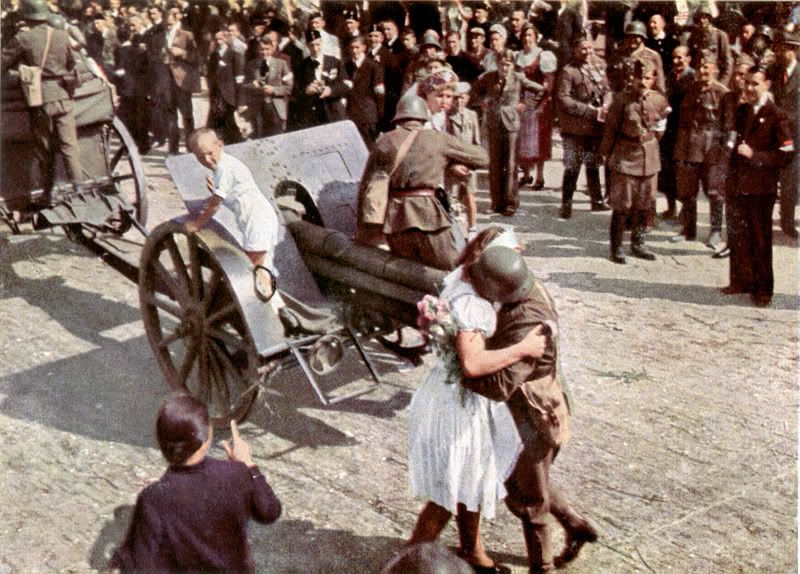
Inscription: Kluj - Kolozsvár, September 11, 1940; After the Homecoming… - Hazatérés után – (photo taken by Balogh Rudolf)
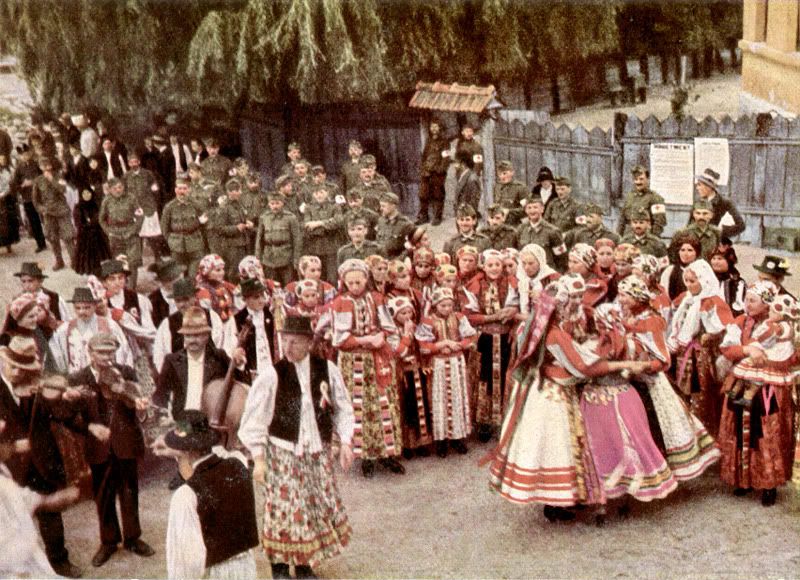
Inscription: Kluj - Kolozsvár, September 11, 1940; Finally, everything is all right – Most már jó – (photo taken by Balogh Rudolf)
Still, these snapshots are not representing the end of the whole story. Those Hungarian reporters actually were dispersed all over the country; therefore you can expect another shipment of previously unpublished color photographs very soon. Until then, honorable ladies and gentlemen – all the best!
The last one of those four links has information in english, like timeline:
http://www.bibl.u-szeged.hu/bibl/mil/ww2/kron/kron_eng.html
Any other Hungary/WWII links in english out there?
Too bad that lot of interesting information is only available in local languages.
Hungary related WWII news
http://hitlernews.cloudworth.com/hungary-war-history.php
_
interesting i always thought that they were just taken over or conqured by hitler at the beginning of the war
Very, very good pictures Librarian 
On one picture i saw german howitzers am i right?
interesting i always thought that they were just taken over or conqured by hitler at the beginning of the war
Yes, my dear Mr. Norris, that’s true – the general stance about the dreadfully multifaceted question of interstate affairs between different nation-states in this section of Europe is concentrated in those words. But, alas, a real life always was and still is much more complex…
Very, very good pictures Librarian.
Thank you, my dear Mr. Panzerknacker. That’s really heartening statement. I have to admit that your posts are representing a truly inspirational motivation in this specific field of our common interest, therefore I do hope that I shall be able to plausibly group and incessantly present some previously undetected photo-material in this thread. 
On one picture i saw german howitzers am i right?
Yes, honorable Mr. Strina-Croatia, you are right. As already emphasized, You can observe a true pride of German artillery engineering – march of horse-towed Rheinmetall 10,5 cm le/FH 18, a truly outstanding construction introduced back there in 1929, and officially accepted within German army units in 1935. But you can also look over for some other wonders of heavy weaponry, or more precisely, for remnants of true ingenuity of Austro-Hungarian Empire, for genuine masterpiece of Dr Karel Skoda, managing director of „Škoda” Imperial artillery material production plant of Plzen, his legendary brainchild, a unique 30.5cm M.11 Mörser - probably the most feared weapon fielded by any Army in WW1, and used with impressive effect both on the Western Front as well in the East, equally in the Balkans and against Italy as well. Yes, I know – it seems desperately outdated, immobile, range – deficient contraption from the ancient times, but, believe me, all those previous remarks are nothing but fruits of misapprehension! Please, if you have some spare time just check this link:
http://www.landships.freeservers.com/305mm_morser_m11.htm
Believe me; you will be able to perceive some true wonders of human disparaging creativity!
After that you will be able to identify those other, above presented and sufficiently intriguing pieces of artillery equipment.
BTW: If I remembered it well, a couple of weeks ago you were interested for some AA gun snapshots. Well, I think that I will be able to find something about those things… Of course, those specialized artillery pieces will be in Hungarian service too.
And now back to our main theme. As previously highlighted, Hungarian reporters were detached directly to the advancing Hungarian troops, therefore they were able to move forward constantly, using all transportation means available. However, it has to be emphasized that most important instrument of this diplomatic triumph was a Hungarian State Railway (MÁV). Between September 5th trough November 27th MÁV has worked extremely well, being capable to carry over more that 29.144 waggons, jam-packed with army personal, equipment, food, fuel, ammunition etc. For these transportation purposes Hungarians have separated more than 178 steam locomotives (14 sequestered ones!), 926 regular pay-hauling MÁV waggons, 1103 privately owned standard cargo-cars, 300 specialized railway platforms, and 126 passenger wagons. All those transportation units were segmented into 492 railway compositions, assembled in a way that every single composition represented an independent mobile army unit, equipped with all necessary equipment (sappers, infantry, artillery, military police, intelligence units, etc.), and leaded by a armored train vanguard, that was capable for all-independent instant action if necessary, as well as for support of independently grouped motorized units, which were used as independent rammers, mainly useful as show-off propaganda instruments. The whole concept was quite a risky one, because of extremely impassable mountainous terrain conditions, with little usable roads and practically without normal transportation opportunity for continuous road-way fuel and spare parts supply. However, railway midpoints, previously successfully occupied by those railway-striking army components, were used as pipelining loops, accomplishing admirable triumph.
Of course, like in every operation, all those results were achieved due to a small group of high-professionals, namely a specially shaped squad of MÁV composed of 14 hauling engineers, 1 bridging engineer, 15 locomotive experts, 12 organizational managers, 386 railway-gauge technicians and 322 skilled railway-construction workers. Their outstanding accomplishment was a key for successful realization of this mission.
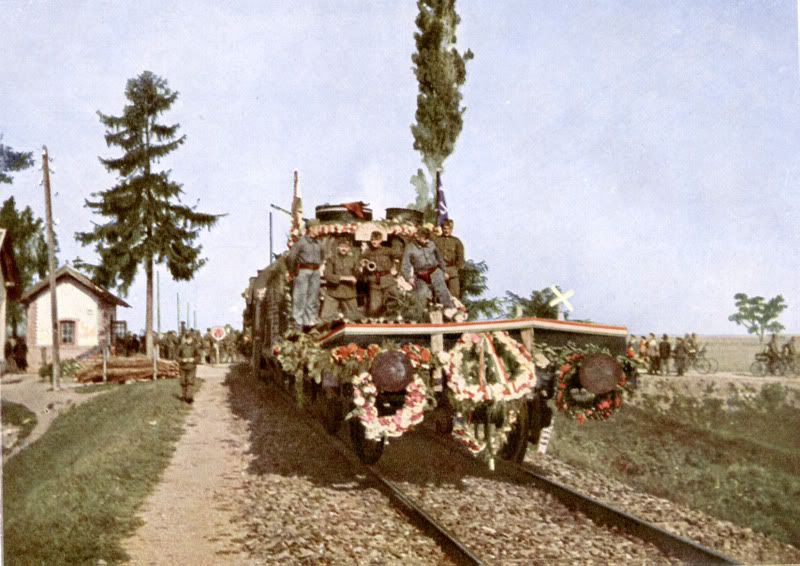
Inscription: Sepsiszentgyörgy, September 13, 1940. - Our armored train on Transylvanian soil - Pancélvonatunk Erdély földjén – (Photo taken by Balogh Rudolf)

Inscription: Transilvania – Erdely, September 13, 1940; On the artillery observation post - A tűzérség figyelőhelyen –– (Photo taken by Ginzery Sándor)

Inscription: Transilvania – Erdely, September 13, 1940. Hungarian field-artillery on march – Tábori tűzérség menetben – (Photo taken by Balogh Rudolf)
To be continued…
Great pictures i wont more!!!They show realy rare hungarian military do you have some pictures of Hungarian armor except the CV-33?
I try to find something Strina-Croatia check this http://wio.ru/tank/hungary.htm and this http://www.onwar.com/tanks/hungary/profiles/pturan2.htm
The second link is very intresting thx
Hello.
I am a new member, and I would like to help translate Hungarian texts. I can’t speak english very good, but I’ll try to help.
Goodby
Welcome oriwalter and thanks for your help.
And now honorable ladies and gentlemen, after many a days, we have some further color photos connected with this pretty unknown Hungarian military operation.
To begin with, we have here one genuine wartime rarity – color snapshot of the Swedish anti-aircraft gun, designed by prominent Bofors company in the late 1920s, designated as 29 M type, and offered on the international market in three different calibres - as the 75 mm L/51, the 76,2 mm L/50 and the 80 mm L/50 respectively. This posterior variant was purchased in small numbers by Greece, Finland, Hungary, Persia and China, and Hungary not only bought those artillery pieces but also actually produced this highly interesting air defense weapon system. It was a modern, mid-cornered, shieldless, recoiless-tubed, machine-towed, semi-automatic-locked weapon. The main parts consisted of a tube and the rear tube, the lock, the upper and the bottom midcorner, the base-plate and the platform. It was highly mobile - it could be combat and fire - ready within 1.5 minutes, and with variety of available ammunition it could be perfectly used against both air and land targets.
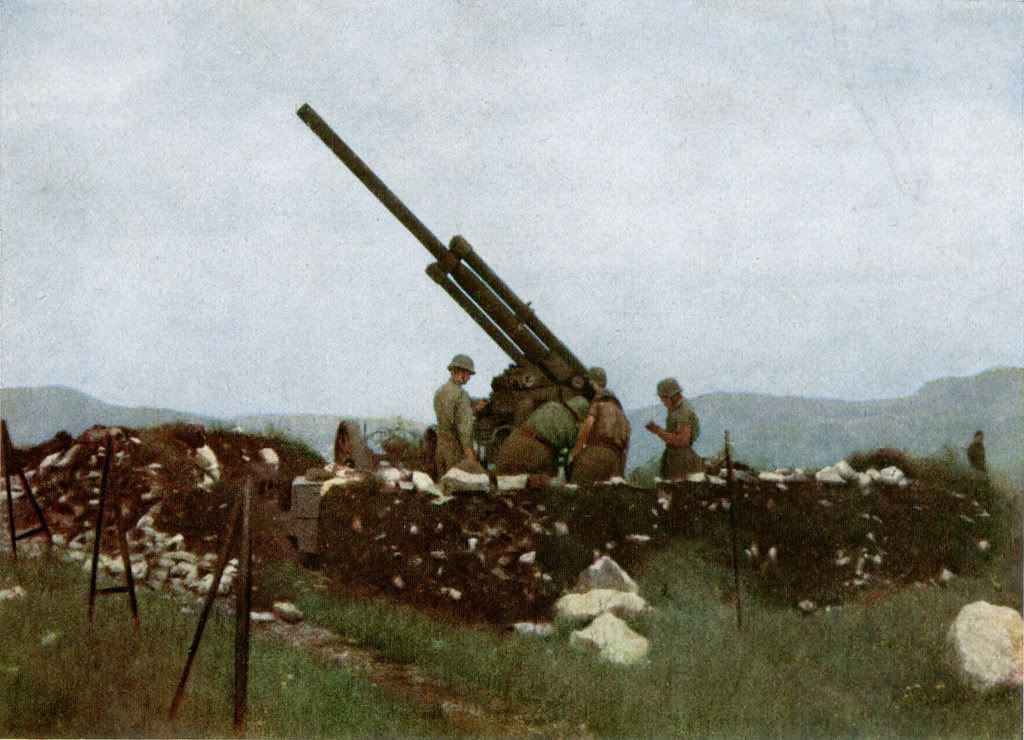
Inscription: Légvédelmi ágyú tüzelőállásban – AA gun up in firing position (Photo taken by Ginzery Sándor)
This artillery have been also used as an anti-tank defense gun, with great success. Although the 40 mm 36Ms and the Nimrods were usually unsuccessful against the heavy Soviet KV and the medium T-34 tanks, previously mentioned Soviet armoured devices were not an obstacle for the pretty forgotten 29Ms.
And we have here some color evocations of the great, old cavalry epoch as well:
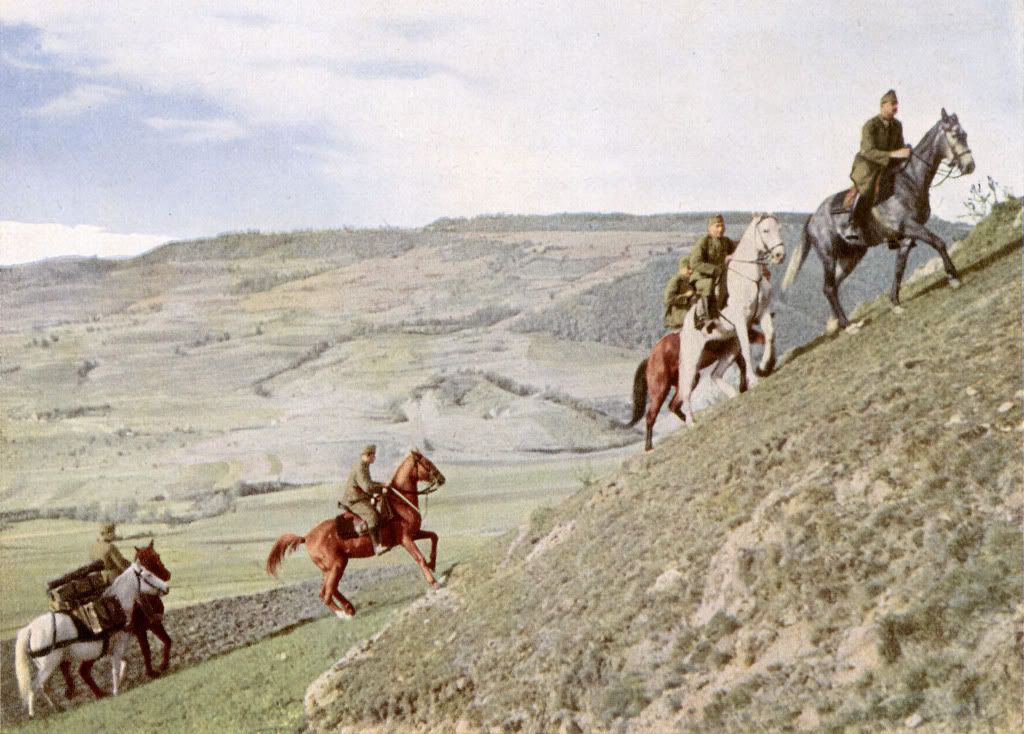
Inscription: Fel a dombra! – Up to the hill (Photo taken by Ginzery Sándor)
To be continued…
In the meantime, as always - all the best! 
And now honorable ladies and gentlemen, after many a days, we have some further color photos connected with this pretty unknown Hungarian military operation.
To begin with, we have here one genuine wartime rarity – color snapshot of the Swedish anti-aircraft gun, designed by prominent Bofors company in the late 1920s, designated as 29 M type, and offered on the international market in three different calibres - as the 75 mm L/51, the 76,2 mm L/50 and the 80 mm L/50 respectively. This posterior variant was purchased in small numbers by Greece, Finland, Hungary, Persia and China, and Hungary not only bought those artillery pieces but also actually produced this highly interesting air defense weapon system. It was a modern, mid-cornered, shieldless, recoiless-tubed, machine-towed, semi-automatic-locked weapon. The main parts consisted of a tube and the rear tube, the lock, the upper and the bottom midcorner, the base-plate and the platform. It was highly mobile - it could be combat and fire - ready within 1.5 minutes, and with variety of available ammunition it could be perfectly used against both air and land targets.

Inscription: Légvéedelmi ágyú tüzelőállásban – AA gun up in firing position (Photo taken by Ginzery Sándor)
This artillery have been also used as an anti-tank defense gun, with great success. Although the 40 mm 36Ms and the Nimrods were usually unsuccessful against the heavy Soviet KV and the medium T-34 tanks, previously mentioned Soviet armoured devices were not an obstacle for the pretty forgotten 29Ms.
And we have here some color evocations of the great, old cavalry epoch as well:

Inscription: Fel a dombra! – Up to the hill (Photo taken by Ginzery Sándor)
Hi Librarian !
As always, very interesting post and pictures.
additional info on hungarian tanks in ww2:
http://mailer.fsu.edu/~akirk/tanks/hun/Hungary.html
Thank you very much for your kind words, my dear Mr. Windrider: and please – don’t worry! I think that I will be able to provide some new materials about those forgotten pieces of heavy weaponry here as well! After all - this is our pretty place for a devoted, matter-oriented conversation 
Hello Everyone,
Very nice photos of Hungarian forces. My father was a Csendor (Hungarian Gendarm) also in Hungarian Army . The Csendors received a lot of bad press, but that was because of the actions of a few, not all.
The second photo on your list looks like Admiral Horthy(not labeled with his name). Anyone interested in good military Hungarian photos (Csendors), check www.csendor.com and press English ,pictures.
Third Picture shows Men with black hats and feathers in back row, these are Royal Hungarian Gendarms or Csendors. Taken from Army units and given extra training to enforce law and order in rural areas. Started in 1880 and kept until Communists took over(1945) when they were captured,tortured,executed for being anti bolshevics/communist. Of the 20000 in 1944 only a few hundred survived. One of their Generals(Seckely)gave up to Allies but was turned back over to Serbian Communists who impaled him (alive) by shoving a wooden pole into his rectum and having it come out of his neck.